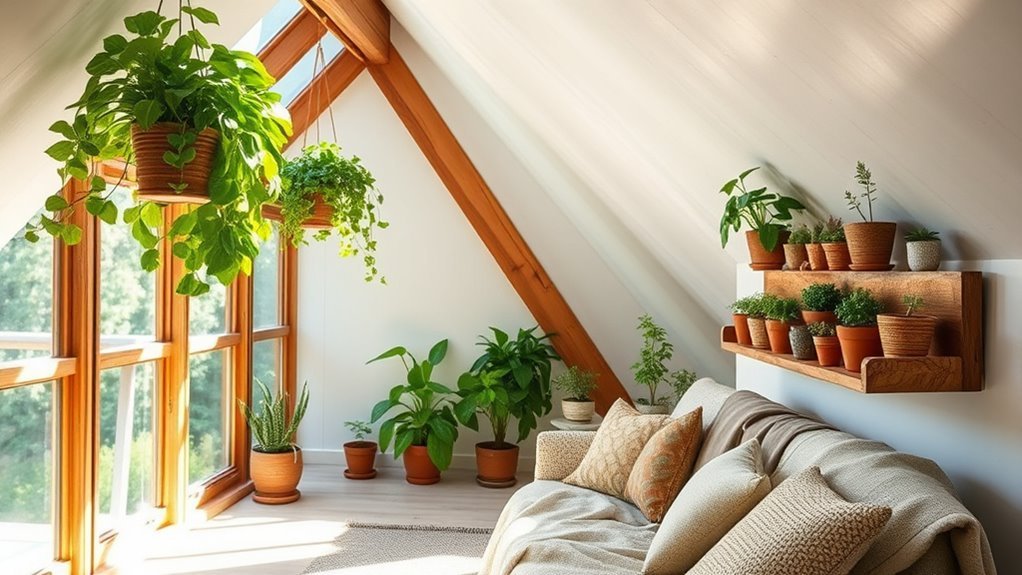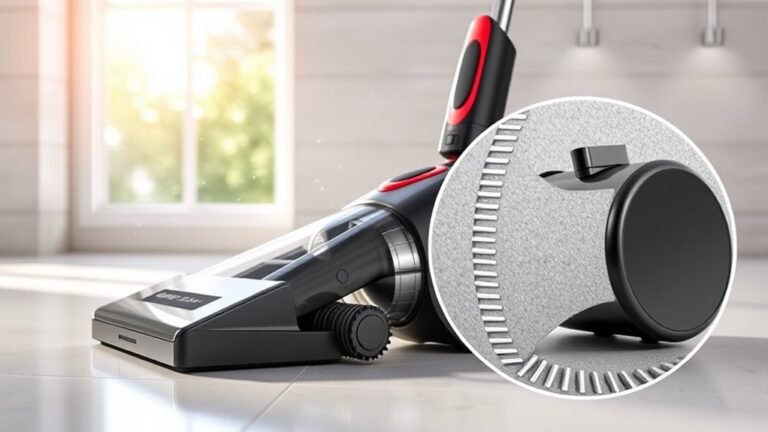Eco-Friendly Alternatives to Attic
You can boost your home’s comfort and lower energy bills by choosing eco-friendly attic alternatives like recycled denim, sheep’s wool, cellulose, or cork for insulation—they’re sustainable and offer great thermal and soundproofing benefits. Combine these with solar-powered ventilation or energy-efficient attic fans to keep air flowing while cutting energy use. Proper air sealing and even green roof integration further enhance efficiency and reduce your carbon footprint. Explore these options to discover practical ways to make your attic greener and more efficient.
Benefits of Eco-Friendly Attic Insulation
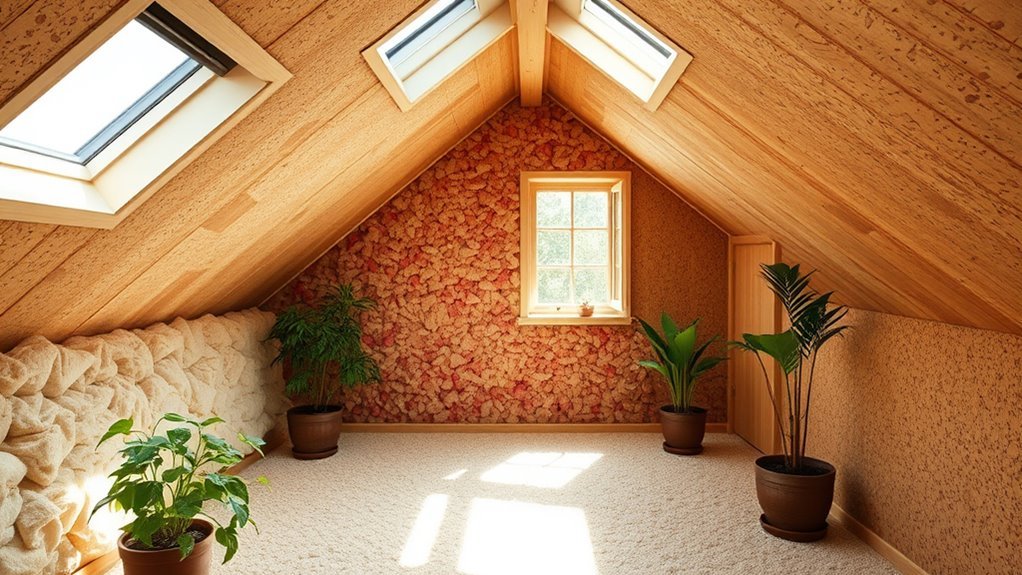
Although traditional attic insulation materials have been widely used, eco-friendly alternatives offer several advantages that can make a significant difference in your home’s energy efficiency and environmental impact. When you choose sustainable insulation, you’re not just helping the planet—you’re revealing long-term cost savings through improved thermal performance. These materials maintain more consistent indoor temperatures, reducing the need for excessive heating or cooling. This efficiency directly translates into lower energy bills, giving you financial freedom while minimizing your carbon footprint. Plus, eco-friendly options often have better durability and moisture resistance, which means fewer replacements and less waste over time. By opting for green insulation, you’re investing in a solution that balances comfort, savings, and environmental responsibility, empowering you to take control of your home’s energy future.
Using Recycled Denim for Attic Insulation
When you’re looking for a sustainable insulation option, recycled denim stands out as an effective and eco-friendly choice. Denim insulation offers impressive insulation performance while reducing landfill waste. Here’s why it’s worth considering:
Recycled denim insulation combines eco-friendliness with high performance to reduce waste and enhance comfort.
- Denim Benefits: Made from post-consumer cotton fibers, it’s free from harmful chemicals, promoting healthier indoor air quality.
- Thermal Efficiency: It provides excellent thermal resistance, keeping your attic comfortable year-round.
- Soundproofing: Denim’s dense fibers naturally absorb sound, enhancing your home’s quietness.
- Durability and Safety: It’s treated with non-toxic fire retardants, ensuring long-lasting protection without compromising your family’s health.
Choosing recycled denim grants you freedom from synthetic materials, reducing your environmental footprint while boosting your attic’s energy efficiency.
Sheep’s Wool as a Natural Insulation Option
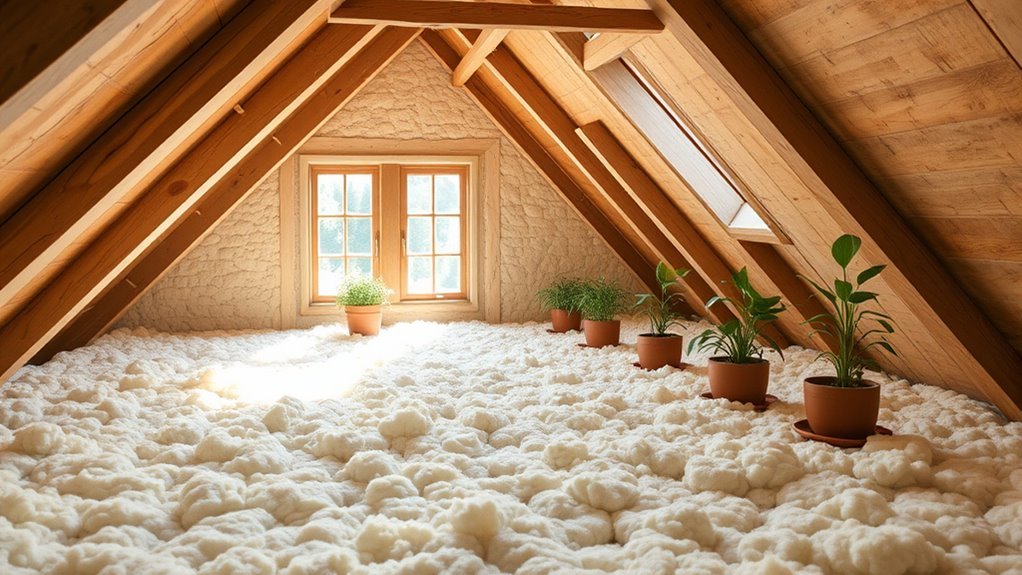
If you’re searching for a natural insulation that balances sustainability with performance, sheep’s wool is an excellent option to contemplate. Sheep wool’s insulation properties are impressive—it naturally regulates humidity by absorbing and releasing moisture without losing effectiveness. This means your attic stays comfortable year-round, reducing energy costs. Plus, sheep wool is renewable and biodegradable, aligning with your eco-conscious values. It’s also fire-resistant and traps air efficiently, enhancing thermal performance. Installing sheep wool is straightforward, and its durability guarantees long-term benefits without frequent replacement. By choosing sheep wool, you’re embracing a solution that’s not only effective but also gentle on the planet, giving you the freedom to create a healthier, more sustainable home environment without sacrificing comfort or efficiency.
Cellulose Insulation Made From Recycled Paper
You’ll find cellulose insulation, made from recycled paper, offers excellent thermal performance while reducing waste. Installing it usually involves blowing the material into your attic, creating a dense, effective barrier against heat loss. Compared to traditional insulation, it has a lower environmental impact, making it a smart choice for eco-conscious homeowners.
Benefits of Cellulose Insulation
Because cellulose insulation is made primarily from recycled paper, it offers a sustainable solution that reduces landfill waste while providing excellent thermal performance. When you choose cellulose insulation, you tap into a range of cellulose benefits that go beyond just eco-friendliness. Here’s what you gain:
- Superior insulation performance that helps maintain consistent indoor temperatures, saving you energy and money.
- Enhanced soundproofing, giving you a quieter, more peaceful living space.
- Resistance to pests and mold, thanks to its dense composition and treatment with natural fire retardants.
- Flexibility in application, allowing it to fill gaps and hard-to-reach areas more effectively than some traditional materials.
Installation Process Overview
Although cellulose insulation is eco-friendly and effective, its installation requires careful preparation and technique to maximize benefits. You’ll need specific installation materials like a blowing machine, protective gear, and proper ventilation equipment. Before starting, verify you take safety precautions such as wearing a mask, goggles, and gloves to protect against dust and allergens. The process involves evenly blowing the recycled paper fibers into the attic space, filling gaps and voids thoroughly to prevent heat loss. It’s essential to maintain consistent density to avoid settling over time, which can reduce insulation performance. By following these steps and using the right tools, you can achieve a reliable, eco-friendly insulation that enhances your home’s energy efficiency while supporting your desire for freedom from excessive energy costs.
Environmental Impact Comparison
Understanding the installation process is just one part of choosing the right attic insulation. You also need to weigh the environmental impact of insulation materials. Cellulose insulation made from recycled paper stands out for several reasons:
- Resource Efficiency: It uses recycled paper, reducing waste and the need for new raw materials.
- Energy Consumption: Manufacturing cellulose requires less energy compared to foam or fiberglass.
- Biodegradability: Unlike synthetic insulation, cellulose decomposes naturally, minimizing landfill burden.
- Emission Reduction: It has a lower carbon footprint during production and installation.
Cork Insulation for Sustainable Attic Solutions
You’ll find cork insulation offers excellent thermal and acoustic properties while being completely natural and renewable. Installing it is straightforward, and with proper maintenance, it can last for decades without losing effectiveness. Let’s explore how cork can provide a sustainable, long-lasting solution for your attic insulation needs.
Benefits of Cork Insulation
When you choose cork insulation for your attic, you’re not only opting for an eco-friendly material but also gaining excellent thermal and acoustic performance. Cork properties make it uniquely suited for sustainable insulation, combining natural resilience with impressive insulation effectiveness. Here’s why cork stands out:
- Energy Efficiency: Cork’s cellular structure traps air, reducing heat flow and lowering your energy bills.
- Soundproofing: Its density dampens noise, creating a quieter, more peaceful home environment.
- Durability: Cork resists moisture, mold, and pests, ensuring long-lasting insulation without harmful chemicals.
- Eco-Friendly: Harvested sustainably, cork renews itself naturally, letting you enjoy freedom from environmental guilt.
Installation and Maintenance Tips
Choosing cork insulation brings many benefits, but its effectiveness depends largely on proper installation and upkeep. When upgrading your attic insulation, make sure the cork panels fit snugly without gaps to maximize thermal performance. You’ll want to seal any joints to prevent air leaks, ensuring your attic stays energy-efficient. For attic maintenance, regularly inspect the cork for signs of moisture or damage, as cork is naturally resistant but not impervious. Address any issues promptly to preserve insulation integrity. Additionally, keep your attic well-ventilated to avoid excess humidity, which can degrade insulation over time. By combining thoughtful installation with consistent attic maintenance, you’ll enjoy lasting comfort and sustainability while reducing energy costs—giving you the freedom to live greener without compromise.
Solar-Powered Attic Ventilation Systems
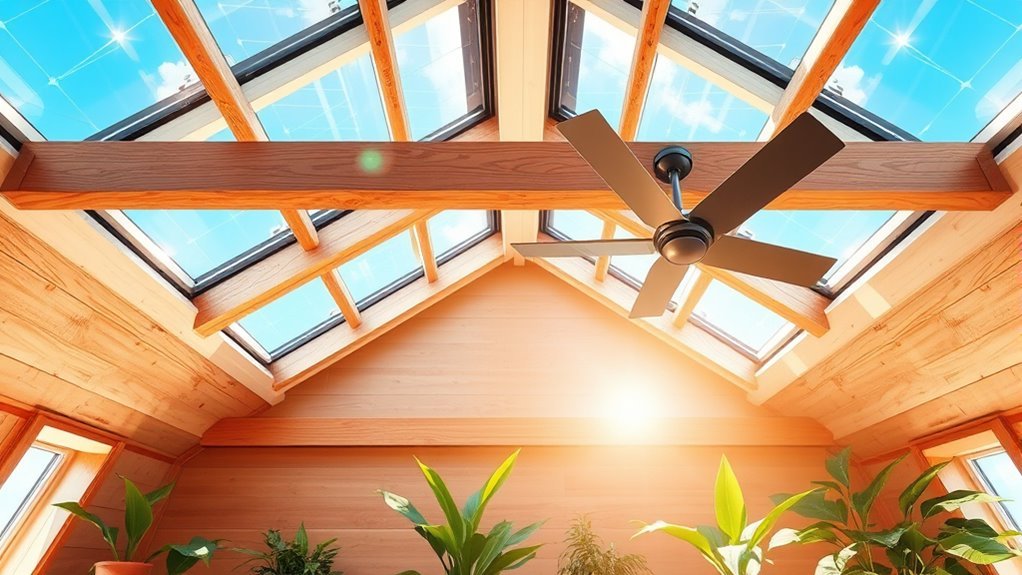
Although traditional attic ventilation relies heavily on electricity, solar-powered attic ventilation systems offer a sustainable alternative that reduces energy consumption and lowers utility bills. By harnessing solar energy, these systems improve attic efficiency while granting you more control over your home’s climate. Here’s why you should consider them:
- They operate independently from the grid, giving you freedom from rising electricity costs.
- Installation is straightforward, typically requiring no complex wiring.
- They work automatically during sunny days, ensuring continuous ventilation without manual intervention.
- Their quiet operation means you won’t notice they’re running, but your attic will stay cooler and drier.
Choosing solar-powered attic ventilation means embracing an eco-friendly solution that keeps your home comfortable and your energy use low.
Installing Attic Fans With Energy-Efficient Motors
Since attic fans play a critical role in maintaining proper ventilation, installing models with energy-efficient motors can markedly reduce your home’s energy consumption while enhancing airflow. When choosing the right fan, consider motor types like brushless DC motors, which offer superior energy efficiency compared to traditional shaded-pole motors. These advanced motors not only consume less power but also run quieter and last longer, giving you greater freedom from frequent replacements and high utility bills. By upgrading to an energy-efficient attic fan, you optimize ventilation without sacrificing your commitment to eco-friendly living. This smart choice helps keep your attic cooler, reducing the load on your HVAC system and ultimately lowering your carbon footprint. Investing in efficient motor types is a practical step toward sustainable home comfort.
Green Roofs and Attic Ventilation Integration
Beyond upgrading attic fans, integrating green roofs with attic ventilation offers a powerful way to enhance your home’s energy efficiency and environmental impact. By combining these two, you reveal several green roof benefits that go beyond aesthetics.
- Improved insulation: Green roofs reduce heat transfer, easing your attic’s cooling load.
- Enhanced airflow: Attic ventilation integration guarantees moisture and heat escape efficiently, preventing damage and mold.
- Energy savings: Together, they lower HVAC demands, cutting energy bills and carbon footprint.
- Extended roof life: Proper ventilation paired with a green roof protects roofing materials from thermal stress.
If you want freedom from high energy costs and environmental guilt, this integration is a smart, sustainable step. It’s a practical eco-upgrade that delivers comfort and savings all year round.
Proper Air Sealing Techniques for Energy Conservation
When you want to maximize your attic’s energy efficiency, proper air sealing is essential. Air leakage compromises your home’s comfort and drives up energy costs by allowing warm or cool air to escape. To combat this, identify common leakage points like gaps around vents, chimneys, and recessed lighting. Choosing the right sealing materials—such as spray foam, caulk, or weatherstripping—depends on the size and location of the gaps. Spray foam works well for irregular or larger spaces, while caulk suits narrow cracks. By effectively sealing these leaks, you prevent unwanted drafts and maintain consistent indoor temperatures. This not only reduces your reliance on heating and cooling systems but also supports a more sustainable lifestyle. Taking control of air leakage gives you freedom from high energy bills and environmental impact.
Frequently Asked Questions
How Do Eco-Friendly Attic Materials Impact Indoor Air Quality?
When you choose eco-friendly attic materials, you’re reducing airborne pollutants because these materials emit fewer harmful chemicals. Unlike conventional options, they release minimal material emissions, improving your home’s indoor air quality. This means you’ll breathe easier and feel more comfortable in your space. Opting for these materials gives you the freedom to create a healthier environment, letting you enjoy your home without worrying about toxic air contaminants lurking above.
Are There Any Health Risks Associated With Natural Attic Insulation?
Think of natural fibers like a double-edged sword when it comes to your attic insulation. While they’re generally safer than synthetic options, some health concerns can pop up, like allergies or mold if moisture gets trapped. You can avoid issues by ensuring proper ventilation and using treatments that resist pests and mildew. That way, you’ll enjoy eco-friendly insulation without sacrificing your health or freedom to breathe easy indoors.
What Is the Average Cost Comparison of Eco-Friendly Vs Traditional Insulation?
When you do a cost analysis of insulation types, eco-friendly options usually have a higher upfront cost than traditional ones. However, they often save you money long-term through energy efficiency and durability. While traditional insulation might seem cheaper initially, eco-friendly materials can reduce your utility bills and increase comfort. So, if you want freedom from high energy costs and environmental worries, investing a bit more now can pay off well later.
How Long Do Eco-Friendly Insulation Materials Typically Last?
When you’re considering insulation longevity, eco-friendly materials often stand out for their material durability. Many natural options like cellulose or sheep’s wool can last 20 to 30 years, sometimes even longer with proper installation and maintenance. This means you’re not only saving energy but also investing in long-term comfort and freedom from frequent replacements. Choosing durable insulation materials lets you enjoy a sustainable, worry-free home environment.
Can Eco-Friendly Attic Solutions Qualify for Tax Credits or Rebates?
You’ll be glad to know that many eco-friendly attic solutions often qualify for tax incentives, which can ease your upfront costs. These incentives reward you for making energy-saving improvements, helping you keep more freedom over your finances. To maximize benefits, check local and federal programs, as eligibility varies. By combining rebates with energy savings, you not only reduce expenses but also contribute to a greener future—empowering your independent lifestyle.
